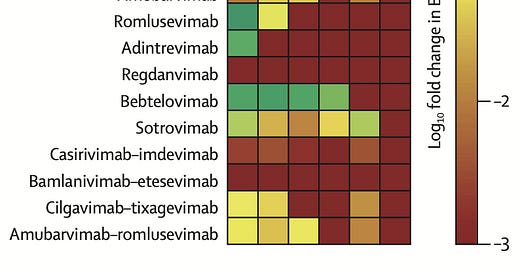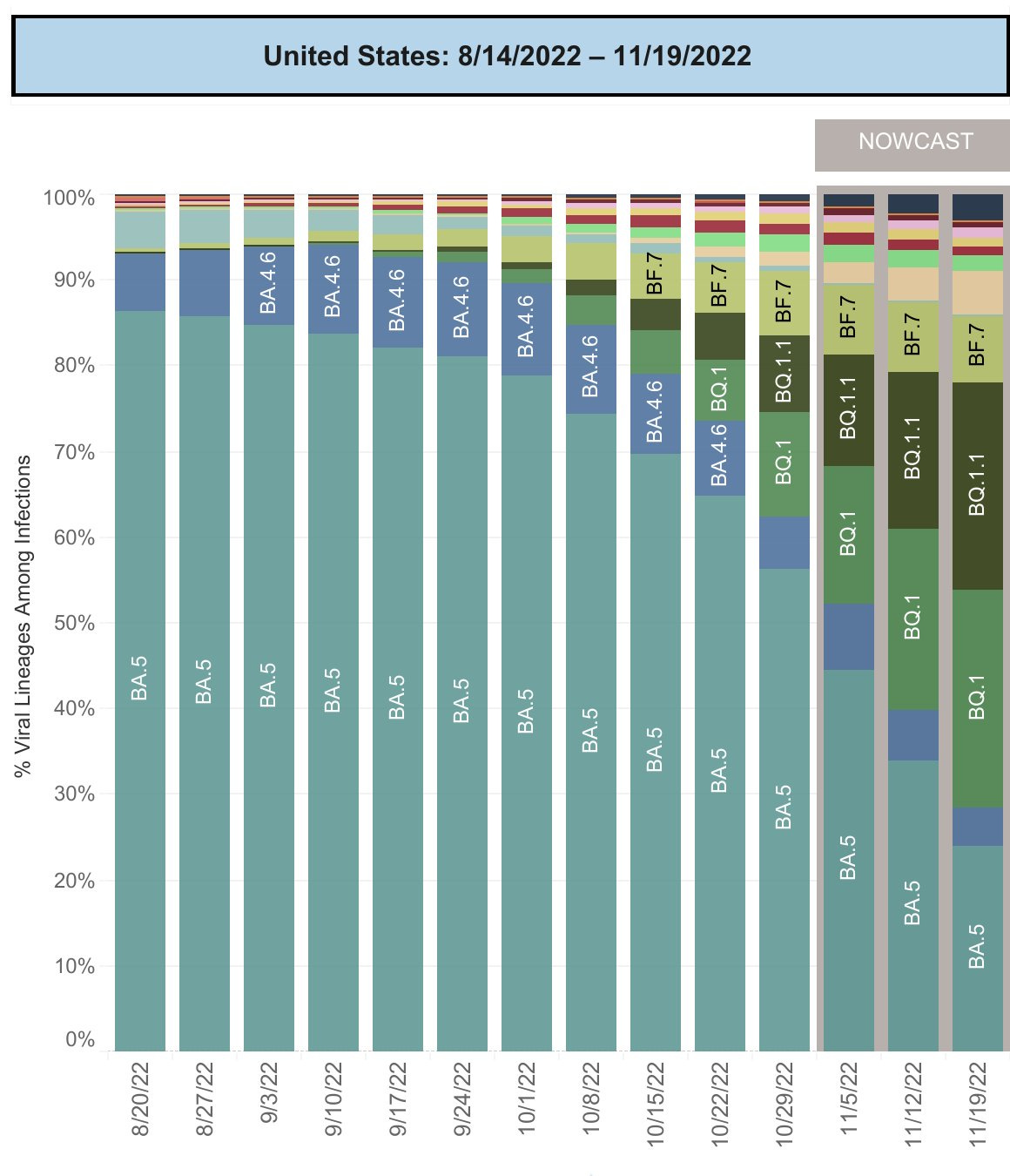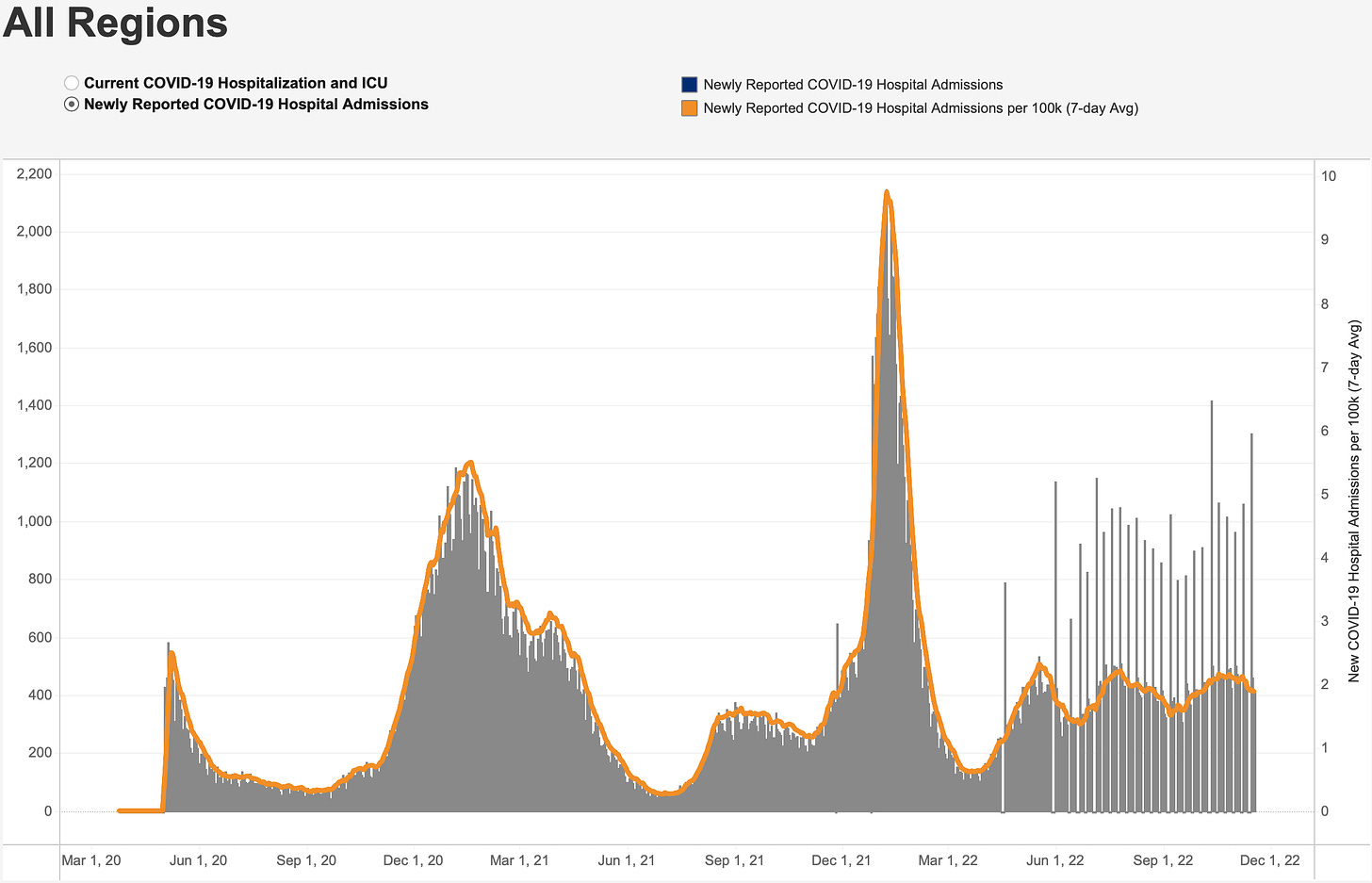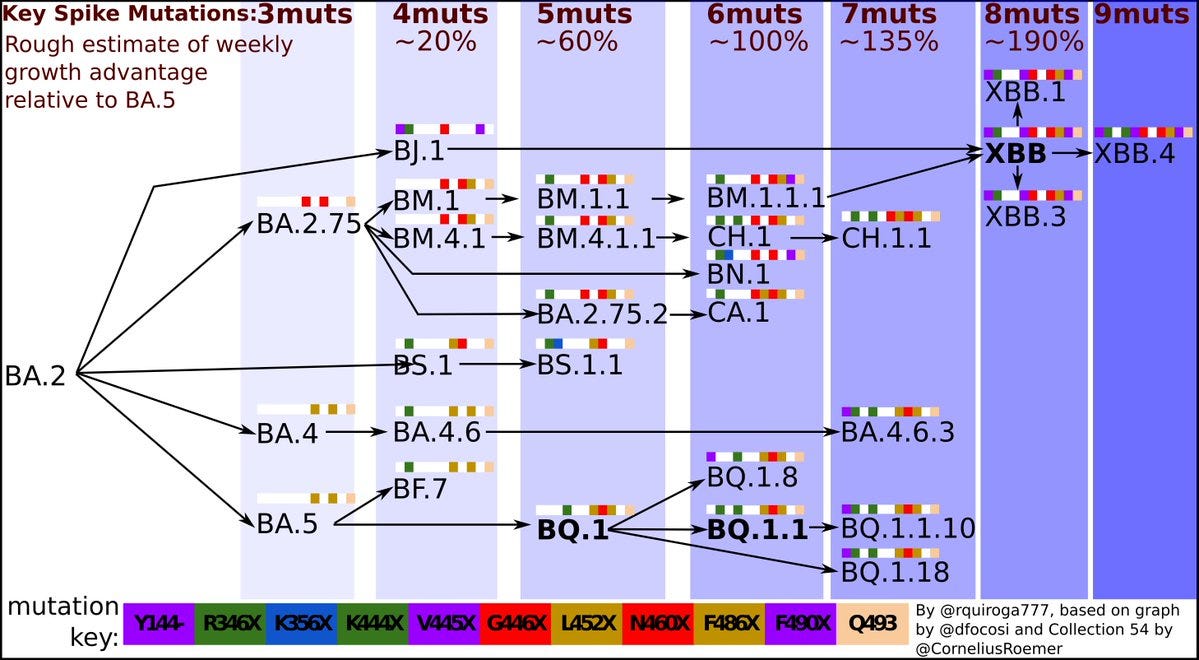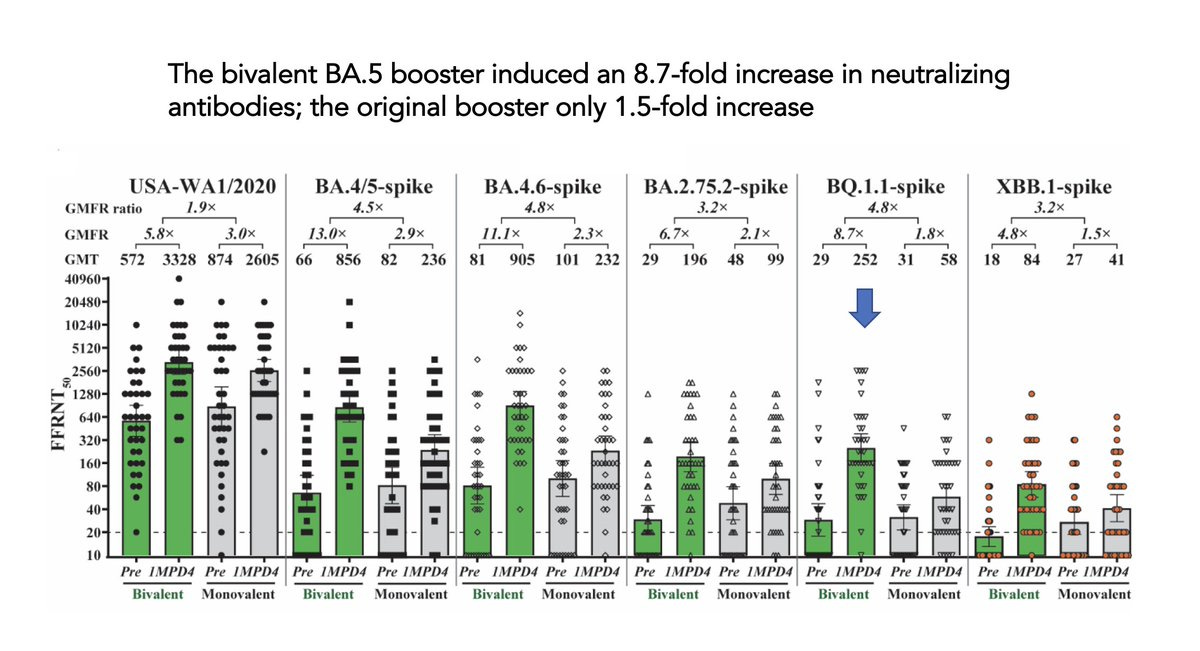The BQ.1.1 variant story
Overall, a very good look and omen for the next couple of months
We’ve been watching the rise of the BQ.1.1 variant for the past several weeks, after having seen Yunlong Cao’s lab assessment of it (and subsequently replicated by multiple labs) to be one the most immune evasive SARS-CoV-2 variants yet seen. A new report by Arora and colleagues from Germany compared resistance to monoclonal antibodies for many of the most troublesome new variants (mutation map of spike protein below) and, unlike the others assayed, showed that BQ.1.1 demonstrates resistance to all available monoclonal antibodies. That certainly reinforces this variant’s immune escape properties.
We’d already seen how BQ.1.1 behaved in France, the first country to get exposed to this variant at high proportion, as I previously reviewed. Along with BQ.1, it became the dominant variant in October (BQ.1.1 at 40% 31 October and then has dropped off) but the rate of hospital admissions were falling at that time and only recently has there been a small increase (with cases as well) as shown below.
Now in the United States BQ.1/BQ.1.1 have become dominant, accounting for more than half of the new cases. Clearly BQ.1.1 is a more concerning variant than BQ.1 (see antibody resistance chart at top) so we’ll await its path to dominance in the weeks ahead to see if that changes anything.
But there is no sign of clinical sequelae to date. Little change in the overall US endpoints that are tracked, as shown here
Moreover, in New York State, which has the highest level of BQ.1.1 in the US, there continues to be no sign of hospital admissions increasing. If anything, that rate is decreasing.
Although there are many other new variants in the swarm (legend at right below) that could ultimately out-compete BQ.1.1, the projection by Moritz Gerstung is that we’ll be sitting in a BQ.1x wave for a couple of months ahead
Why is this good news?
Here you can see Rodrigo Quiroga’s (rquiroga777) updated graphic of the evolution of variants and number of mutations (must) acquired as descendants from BA.2. BQ.1.1 has 6; its growth advantage had been as high as ~100% relative to BA.5 but now has fallen to 50-60%. BQ.1.1.10, with 7 mutations, has been shown to have a bit more immune evasion and so far, the extreme case of added mutations (with 9) is XBB.4, further evolved from recombinant XBB, which induced a wave of cases in Singapore (with a highly vaccinated and boosted population) but only a limited increase in hospitalizations and deaths.
And here is JP Weiland’s graph showing how the growth advantage of BQ.* relative to BA.5 has dropped over time. This may not be intrinsic to BQ* but rather that other variants (there’s no shortage of them in the mix) are starting to crowd it out, slowing its growth arc.
This is the first time in the pandemic that a variant with clearcut, marked immune evasion has not induced a major new wave. Examples of prior variants with increases in immune escape properties include Beta, Gamma, Omicron BA.1, BA.2, and BA.5. Each of these led to major waves globally or in specific continents (Beta in South Africa, Gamma in South America).
Under pressure from prior infections, vaccinations, boosters and combinations of these, the virus is having a harder time finding new hosts. To date, BQ.1.1 has not been able to induce a new wave in 2 countries, a very positive sign. Sure, there are Omicron lineages with 7 mutations on top of BA.2, like CH.1.1 and BQ.1.1.10, and 8 or 9 mutations (XBB.3 and 4) but are they going to look any different? You might think that BQ.1.1 would qualify as an acid test and so far its outcome looks far more favorable than initially projected. For further context, all of this is happening with minimal mitigation, such as the very low use of masks or avoidance of indoor gatherings. No less in colder weather, heading into winter.
More Good News from the Bivalent Booster
There have been 2 reports that the BA.5 bivalent booster has some neutralizing antibody cross-protection against BQ.1.1. First was Emory’s report, that showed a >5-fold increased neutralizing antibody response with the bivalent vs BQ.1.1 as compared with a single original booster.
and then the U Texas Galveston Shi lab report with about a 5-fold increased neutralizing antibody response for the bivalent to BQ.1.1 compared to the monovalent, original booster. Both of these studies showed a similar bivalent benefit vs. BA.2.75.2, a variant in the wings that could pick up steam in the months ahead.
Sadly, the uptake of bivalent boosters in the US is poor, especially in the people who would derive the most benefit.
The cross-immunity protection of a BA.5 breakthrough infections was also substantiated by this report in a small number of participants showing a good response to BQ.1.1, along with other variants we’re watching (BA.4.6 and BA.2.75.2).
Is this the End of the Line?
It would be tempting to interpret the lack of impact of BQ.1.1, relative to its immune evasion properties, as we’re out of the woods. A population-level immunity wall has been built up over 3 years, with all the infections and vaccinations. Further, our T-cell immunity from these exposures, which isn’t assessed with these neutralization antibody assays, is helping us defend against variants. The optimistic viewpoint is that there’s little more that the Omicron family can throw at us which will be much worse than what we’ve already seen. That we’re done, going endemic, that the acute phase of the pandemic with big waves is over.
Not so fast. As Daniele Focosi reminded us this week, the SARS-CoV-2 mutation rate has increased by 30% in the past year. There still could be room within Omicron, and especially the XBB recombinants, to pose a significant threat. Moreover, there’s the dismal prospect of a whole new family of variants to emerge (e.g. Sigma) that are distinct from the mutation cascade we’ve seen from Omicron for over a year.
Another concern is that BQ.1.1 is going to cause some trouble. It has blown through Evusheld protection, a vital help for immunocompromised people, and left us without a monoclonal antibody treatment that works for people at high-risk not responding to (or unable to take) Paxlovid. Sadly. we see no new monoclonal on the short term horizon to take their place, even though so many very broad neutralizing antibodies (with potential of being variant-proof) have been identified in many academic labs.
Gearing Up
With the caveats above, there’s a good look for at least a couple of months. Beyond that, however, there’s potential for more difficult times. That’s why it’s still essential to develop ways to achieve mucosal immunity to block infections and spread (which the Omicron variants have largely overridden vaccine/booster protection) and take advantage of all the work that led to numerous pan-sarbecovirus and pan-beta-coronavirus neutralizing antibodies that are templates for variant-proof vaccines. It is preposterous that a small investment in these efforts has been thwarted by Congress (specifically Republicans). This is the epitome of complacency, or even stupidity, since this virus isn’t going to just go away. Unfortunately, it can and will likely continue to haunt us for years to come.
Meanwhile, it sure looks like a good stretch ahead for the holiday season. And, of course, there are things you can do to maximize protection (like a bivalent booster and high quality masks).
Wishing you a Happy Thanksgiving and appreciate your taking the time to read these newsletters. If you find them useful, please share and subscribe.

